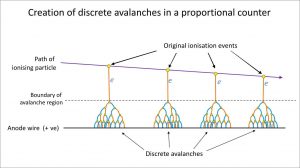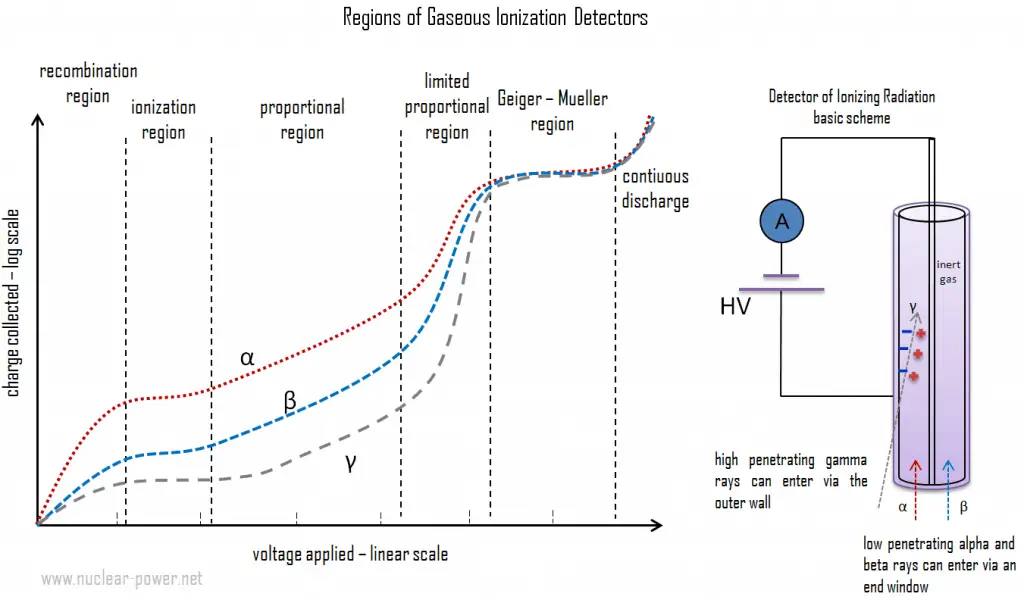
A proportional counter, also known as the proportional detector, is an electrical device that detects various types of ionizing radiation. The voltage of the detector is adjusted so that the conditions correspond to the proportional region. In this region, the voltage is high enough to provide the primary electrons with sufficient acceleration and energy to ionize additional atoms of the medium. These secondary ions (gas amplification) formed are also accelerated, causing an effect known as Townsend avalanches, which creates a single large electrical pulse.
Advantages of Proportional Counters
- Amplification. Gaseous proportional counters usually operate in high electric fields of 10 kV/cm and achieve typical amplification factors of about 105. Since the amplification factor strongly depends on the applied voltage, the charge collected (output signal) also depends on the applied voltage, and proportional counters require constant voltage. The high amplification factor of the proportional counter is the major advantage over the ionization chamber.
- Sensitivity. The process of charge amplification greatly improves the signal-to-noise ratio of the detector and reduces the subsequent electronic amplification required. Since the process of charge amplification greatly improves the detector’s signal-to-noise ratio, subsequent electronic amplification is usually not required. Proportional counter detection instruments are very sensitive to low levels of radiation. Moreover, when measuring current output, a proportional detector is useful for dose rates
since the output signal is proportional to the energy deposited by ionization and
therefore proportional to the dose rate. -

This diagram shows the number of ion pairs generated in the gas-filled detector, which varies according to the applied voltage for constant incident radiation. The voltages vary widely depending on the detector geometry, gas type, and pressure. This figure schematically indicates the different voltage regions for alpha, beta, and gamma rays. There are six main practical operating regions, where three (ionization, proportional, and Geiger-Mueller region) are useful for detecting ionizing radiation. Alpha particles are more ionizing than beta particles, and gamma rays, so more current is produced in the ion chamber region by alpha than beta and gamma, but the particles cannot be differentiated. More current is produced in the proportional counting region by alpha particles than beta. Still, by the nature of proportional counting, it is possible to differentiate alpha, beta, and gamma pulses. In the Geiger region, there is no differentiation of alpha and beta as any single ionization event in the gas results in the same current output. Spectroscopy. The proportional counter can detect alpha, beta, gamma, or neutron radiation in mixed radiation fields by proper functional arrangements, modifications, modifications, and biases. Moreover, proportional counters are capable of particle identification and energy measurement (spectroscopy). The pulse height reflects the energy deposited by the incident radiation in the detector gas. It is possible to distinguish the larger pulses produced by alpha particles from the smaller pulses produced by beta particles or gamma rays.
Disadvantages of Proportional Counters
- Constant Voltage. The voltage must be kept constant when instruments are operated in the proportional region. If a voltage remains constant, the gas amplification factor also does not change. The main drawback to using proportional counters in portable instruments is that they require a very stable power supply and amplifier to ensure constant operating conditions (in the middle of the proportional region). This isn’t easy to provide in a portable instrument, so proportional counters tend to be used more in fixed or lab instruments.
- Quenching. Each electron collected in the chamber has a positively charged gas ion left over. These gas ions are heavy compared to an electron and move much more slowly. Free electrons are much lighter than positive ions. Thus, they are drawn toward the positive central electrode much faster than the positive ions drawn to the chamber wall. The resulting cloud of positive ions near the electrode leads to distortions in gas multiplication. Eventually, the positive ions move from the positively charged central wire to the negatively charged wall and are neutralized by gaining an electron. In the process, some energy is given off, which causes additional ionization of the gas atoms. The electrons produced by this ionization move toward the central wire and are multiplied en route. This charge pulse is unrelated to the radiation to be detected and can set off a series of pulses. In practice, the avalanche’s termination is improved by using “quenching” techniques.
Special Reference: U.S. Department of Energy, Instrumentation and Control. DOE Fundamentals Handbook, Volume 2 of 2. June 1992.